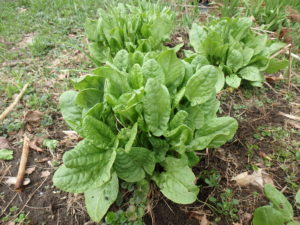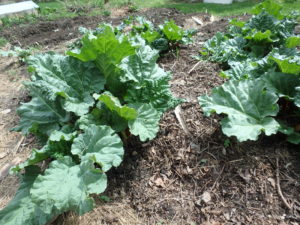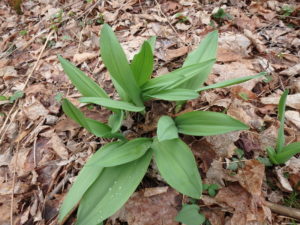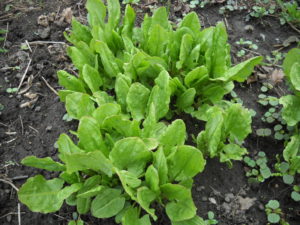Harvesting Now from the Vegetable Garden
It occurred to me as I walked up from my vegetable garden recently with a dozen fat parsnips, that gardening has something in common with fishing: you never know if you’re going to come home with something for dinner or not. Those parsnips, which were planted last summer, had spent the winter in the garden. Mice or voles might well have eaten them up – but they didn’t.
Parsnips, carrots and potatoes can spend the winter in the ground without injury –other than the risk of rodent damage. In fact, I leave most of my parsnips in the ground each fall because they taste sweeter in the spring. I mulched them well with straw in the fall.
Once the soil has dropped below 50 degrees F some of the carbohydrates turn to sugars. That’s why commercial potato growers store their spuds in temperature-controlled places that are above 50 degrees. MacDonalds and other big buyers of potatoes don’t want potatoes with high sugar content – they burn, or darken, when frying. So they carefully monitor temperatures, ensuing they stay a little above 50 degrees.
It’s not time to plant parsnip seeds yet, but I bought my seeds this week. Parsnip seeds are only good the year you bought them, so if you have left over seeds from last year, toss them out and buy new seeds.
Parsnip seeds take forever and a day to germinate – I have been known to wait a month to see them appear, even though the seed package might say they’ll start growing in 2 weeks. Wait until the soil warms up well before planting – late May or even early June is best.
Plant parsnip seeds half an inch deep and an inch apart in rows that are 6 inches apart. In a wide raised bed you can plant multiple short rows across the bed. Then, after your parsnips are a couple of inches tall, thin them to 3 to 4 inches apart. Even though they tend to grow straight down into the soil, they send tiny roots laterally and don’t like to be crowded.
If you are not familiar with parsnips, go to your local food co-op and buy a few and cook them up. After you’ve tasted them, you’ll know if you want to grow them or not. They are related to carrots, but have their own distinct flavor. You can steam or boil them like carrots, and serve with butter and a little hot maple syrup if you like.
Another recipe I like uses potatoes, parsnips and sorrel, an early-season green. Just peel and chop a pound of potatoes and 3/4 pound of parsnips; boil them until soft. Cut up a cup of sorrel and sauté in 2 ounces of butter until soft and mushy. Mash the root crops when cooked, add the sorrel and some heavy cream. Yum!
My sorrel is up now, and will be ready to harvest in early May. Sorrel is a great favorite of French cooks who make a soup with it. Although I grow it, I sometimes forget it’s there and overlook it. It’s a bright leafy green that comes back, year after year. It has a sharp lemony flavor, a bit like wood sorrel.
My problem with it is that when you cook it, it practically disappears. It has little substance. But it’s easy to grow, and adds a unique flavor if added to a salad or even a sandwich. Plants are often sold at garden centers in the herb section.
What else is coming up in the garden? Rhubarb. This sharp-flavored perennial stalk is a favorite of mine. Some varieties have deep red stems, others are green with just a hint of red. All will make you pucker up if you take a bite raw. The leaves contain oxalic acid, and are said to be poisonous.
I love rhubarb pie, strawberry-rhubarb pie, rhubarb sauce and rhubarb tea. You know the pies and sauce, I suppose, but the tea? It’s easy to make. Chop up a few stems and boil in an equal quantity of water. Once it gets mushy you can strain it and add more water and some sugar until you have a nice drink. I just use a little sugar – I like the tea plenty tart. I like to use red stems for the tea, as it looks so nice in a glass or cup. I drink it cold, too.
Chives are another perennial vegetable or herb. Mine are just up now and a couple of inches tall, despite the snow nearby in the same bed. This tasty fellow is best known as a garnish for baked potatoes, along with sour cream. It is one of the few things that will winter over easily in a pot on the kitchen window sill. But look for yours now, when there is little fresh in the garden to harvest.
I also grow garlic chives, but mine aren’t up yet. Garlic chives are bigger than chives and the flavor is bolder. I like them for their fuzzy white flowers that appear in early summer. The leaves are not hollow like chives, but flat. They are commonly used in Asian cooking. They’ll be along shortly.
I wish I had more perennial vegetables. Wouldn’t it be great if our tomatoes and squash came back like rhubarb, year after year?
Henry is a UNH Master Gardener and a gardening consultant. He is the author of 4 gardening books. His web site is www.Gardening-Guy.com.
A Taste of Spring!
I’m already eating a few of my own fresh vegetables: ramps, dandelion greens and sorrel are ready, and soon will come those perennial delicacies, asparagus and rhubarb.
It took me nearly 10 years, but I now have a patch of ramps that produces enough of these wild members of the onion family that I don’t have to go hiking to dig up the ramps I need. I sauté both the bulb and the leaves, and find them a great spring treat in eggs or a stir fry.
Ramps are often found in areas with moist soil and filtered sun and shade. They are slow-growing, but I have added 50 or so plants most years for 10 years and the older clumps are ready for harvesting.
Ramps often are found in patches of a million or more, but that does not mean you can be careless about harvesting them – a patch that sizes takes a lifetime or more to develop. Dig a few in one spot, move to another – and never take all from any one location. If I dig out 25 from one spot, I am sure to leave half a dozen in the ground.
If you want to start your own patch, first learn to identify the plant. They have leaves that are 6 to 12 inches long and 1 to 3 inches wide with a pointy end. There is a groove down the middle of the leaf, and the lower stem may have some maroon coloring. And the scent is distinct, similar to garlic and leeks. The bulbs are half an inch wide or so, and two inches long or less, depending when you pull them. There is an outer sheath over the bulb which you should slide off when you cut off the roots.
To grow your own, carefully observe where you find them in the wild. Look at the trees: often maples and beech, sometimes ash or poplar form the canopy. Wildflowers that grow along with ramps include spring beauty, Dutchman’s breeches and trout lily.
The soil for growing ramps should be rich and dark. If you want some near the house and kitchen, dig some up and try to match the environment where you find them in the wild. Be sure to ask the landowner if you want to take some from a neighbor. These are spring ephemerals, so the leaves will die and disappear before mid-summer.
I know that many gardeners think of dandelions as pests, and they can be. But they are also tasty if you dig some before they bloom; after blooming they tend to get bitter.
To harvest dandelions, bring a table knife with you to a patch of lawn or garden that has not been treated with chemicals – no herbicides, no chemical fertilizers, no pesticides. Slice the roots an inch beneath the soil surface and lift the dandelion carefully as you don’t want to sprinkle any soil onto the greens. The white portion just beneath the soil is delicious, but you can toss the brown-skinned tap root.
I wash the dandelions with the sprayer in my kitchen sink, and then leave the roots in a bowl of water to loosen any more soil. Then I return and rinse them after soaking. I like to steam them lightly, then serve with cider vinegar or a little butter. Although I eat them the same day I pick them, my late friend Rev Wightman used to freeze them and eat them throughout the year.
Sorrel is a great favorite of French cooks who make a soup with it. Although I grow it, I am not wild about it. It is a bright leafy green that comes back, year after year. It has a sharp lemony flavor, a bit like wood sorrel. My problem with it is that when you cook it, it practically disappears. It has little substance. But it’s easy to grow, and adds a unique flavor if added to a salad or even a sandwich. Plants are often sold at garden centers in the herb section.
My rhubarb is up! I love rhubarb for its sharp flavor, one that I have been told is among the last to disappear for the elderly when they lose their ability to sense flavors.
Rhubarb is easy to grow. It does best in full sun with rich moist soil. I have grown it in dry soil and although it grows in dry places, it is not as vigorous. It has a deep fleshy root. If you have a friend with a rhubarb patch, it is easy to dig some out and bring it home. Just plunge a spade into the middle of a plant, and then around it, and lift out a section of root. Add plenty of compost and organic fertilizer to the soil when you plant it.
Rhubarb comes in green-stemmed and red-stemmed varieties. I like the red, though I doubt there is a difference in taste. The leaves are a little toxic – they contain oxalic acid – but are not going to kill you if you eat some.
For a spring drink, chop a pound of stems, add water, and boil until soft. Drain off the mush, add some sugar and more water for a tasty pink drink that has got to be healthier for you than soda!
Eating seasonally is good for you – and I like having treats now that I only get once a year. Soon fiddleheads will be up – but more on that another day.
Henry’s blog appears twice a week at https://dailyuv.com/








